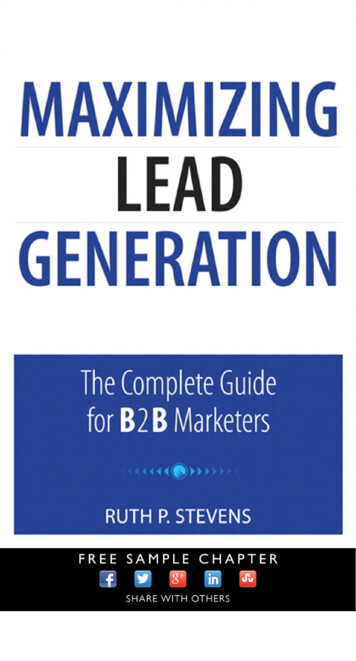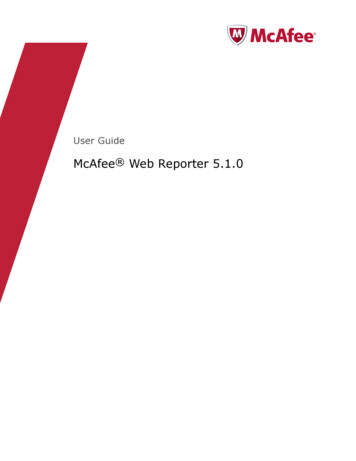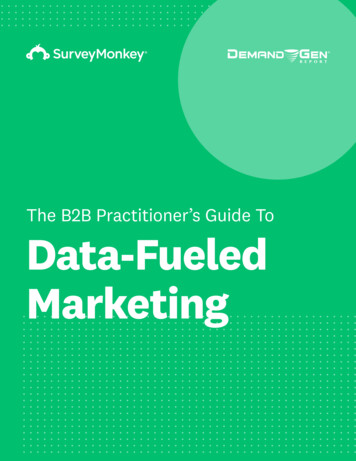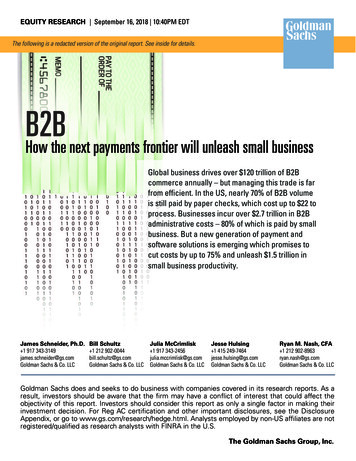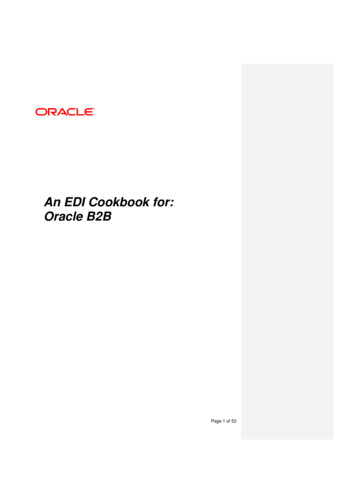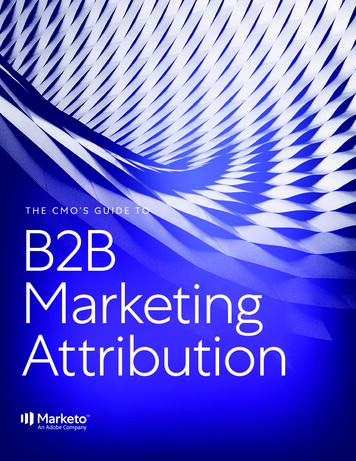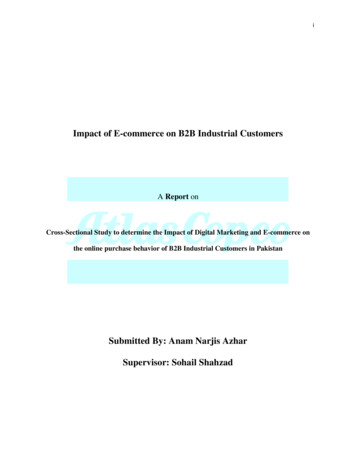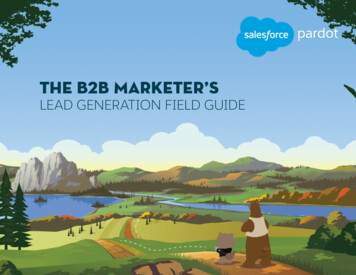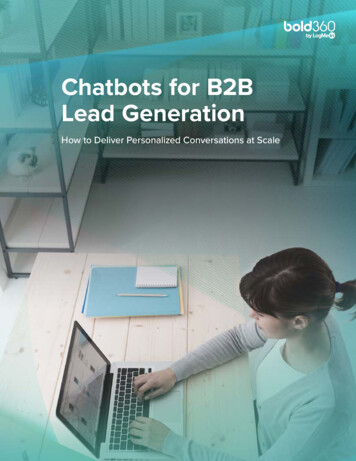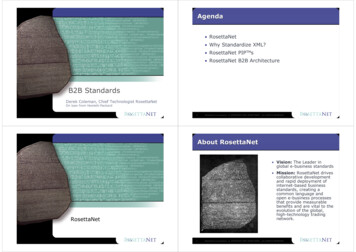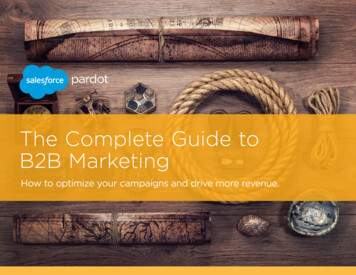
Transcription
The Complete Guide toB2B MarketingHow to optimize your campaigns and drive more revenue.
TABLE OF CONTENTSINTRODUCTION .3CHAPTER four .32Be a better B2B marketer.Be better at email marketing.Get a glimpse into the challenges of modern B2Bmarketing — plus a first look at the best practices,tips, and advice this e-book provides.Learn how to build a successful email program fromstart to finish, and optimize your messages for theinbox.CHAPTER ONE .4CHAPTER five .43Be better at lead generation.Learn how to generate high-quality leads withmarketing automation features like landing pages,forms, and progressive profiling.Be better at content marketing.Learn to create and implement an effective strategythat promotes and tracks B2B marketing content.CHAPTER six .55CHAPTER two 13Be better at lead qualification.Be able to distinguish between lead scoring and leadgrading, and learn why you need both.Be better at webinars and events.Make the most of your B2B marketing eventsinvestment.CHAPTER SEVEN .64CHAPTER THREE 22Be better at lead nurturing.Depending on your level of experience, this chaptercan help you lay the groundwork for successfulnurturing campaigns or help you improve theprocesses you already have in place.Be better at social media.Optimize your social media accounts by planning asocial content strategy, building a following, and setting(and reaching) goals.CHAPTER EIGHT .72Be better at ROI reporting.Get a quick overview of closed-loop reportingand a list of valuable ROI metrics to track.2 / Pardot
INTRODUCTIONintroBe a better B2Bmarketer.In early 2015, Salesforce conducted a survey of more than2,100 global marketers to better understand the currentstate of B2B marketing. The results proved that B2Bmarketers are as time-strapped as ever, and consistentlygrapple with three main challenges: new businessdevelopment, lead quality, and lead generation.But that’s not all that B2B marketers have on their plates.The emphasis on a more cohesive, personalized sellingprocess is growing, leading many marketers to increasetheir investments in technologies that can help themcreate 1:1 buying experiences. Marketers now own more ofthe lead-to-revenue cycle than ever and are responsiblefor engaging with buyers throughout the entire customerlifecycle.In an increasingly digital and data-driven world, thismeans more than well-timed emails and the occasionalclever Tweet. Marketers need to think bigger — and thise-book can help.The following chapters will guide B2B marketers throughthe eight main pillars of digital marketing, with checklistsand worksheets provided at the end of each chapter.Whether you’re building a B2B marketing strategy from theground up or you’re working to perfect the strategy youalready have in place, you’ll find valuable insights on how to: build effective and measurable lead generationcampaigns qualify and assign leads to sales — at the right time increase the value of your database using targetednurturing programs create engaging emails that resonate with your targetaudience develop a content strategy that supports your overallbusiness goals build a webinar and event marketing strategy fromthe ground up engage with your target audiences over social mediain an authentic way report on the success of your marketing initiativesStart your journey to becoming an even better B2B marketer.Let’s dive in!3 / Pardot
CHAPTER ONEoneBe better at leadgeneration.B2B marketers are facing an ever-increasing demandfor more high-quality leads. In fact, according to B2BTechnology Marketing Community, marketers’ leadgeneration budgets have increased 50% since 2013,demonstrating the growing number of resources thatmarketers are investing in lead generation initiatives.In the B2C world, lead generation typically starts andends in the same place: the purchase. On the otherhand, B2B marketers with long, complex sales cycleslook at conversion as getting a visitor to fill out aform in exchange for something of value, such as awhite paper, a product demo, or a free consultation.The purchase may be months — or even years —away. Landing pages with hosted forms are often thede facto method for these conversions, which is whyoptimization is so crucial to the sales and marketingprocess.According to a 2015 study by Regalix, 84% ofmarketing executives indicate that lead generation isthe number one benefit of a marketing automationtool. The first chapter of our guide takes a look athow marketing automation features like landing pages,forms, and progressive profiling can help marketers boostthe effectiveness of their lead generation programs.Creating Effective Landing PagesLanding pages are a key ingredient in lead generation,but building the perfect landing page isn’t always easy. Itrequires a great deal of testing and analyzing — combinedwith eye-catching visuals and persuasive copy — to builda landing page that will not only decrease bounce rates,but will also increase conversions and the amount of timevisitors spend interacting with you.Historically, landing pages were primarily used for basicdata collection, but today their usage has evolved. Now,landing pages can be used as launch pads to drivevisitors deeper into your site, directing them to morevaluable content. With tools like marketing automation atyour disposal, you can create landing pages, forms, copy,and calls-to-action that are optimized for that purpose:to keep your visitors engaged on your site, even afterthey’ve already converted.4 / Pardot
So where do you begin?Start with your value proposition. Your buyers arefaced with information overload and endless options,so their time is both limited and valuable. To breakthrough the clutter and hold their attention, youroffer needs to be both compelling and persuasive.Use strong calls-to-action and benefit-focusedlanguage to convey value, and be sure to keep thefocus on your buyers, not on you.To get more information about crafting the perfectcall-to-action, see the checklist at the end of thischapter.Create points of engagement. Engagement ona landing page is a function of a few core items:sightlines (where users look on the page), copy,calls-to-action, and images.68% of B2B businesses uselanding pages to garnernew sales leads for futureconversion.- MarketingSherpaSIGHTLINES AND COPYIt’s important to keep the following facts in mind whendesigning your landing page for optimum engagement: Text is almost always scanned, and not readentirely. Greater focus is given to words in the top andleft side of the page. Text is scanned in what’s called an f-pattern.According to Nielsen Norman Group, before a visitorleaves, they’ll read — at most — 28% of the words on apage.If you need more than a couple of short paragraphs oftext on your landing page, make sure the first words inthose paragraphs give a clear indication of what they’reabout. If you can divide the content into sections, do so!Make sure you write concise headings to help scanningeyes find the information they’re searching for.calls-to-action and ImagesPlacing your offer behind a form is an essential part ofgenerating leads, but it helps to include some value upfront. Experiment with calls-to-action and gated versusungated content. Try gating your main offer behind aform while still sharing an unprotected piece of contentfor free, like an infographic, video, or calculator.5 / Pardot
This allows visitors to see the caliber of your contentwithout having to give up any of their personalinformation first.You can (and should) still tease the downloadableasset using images on your landing pages. A goodsolution for this is to provide a small image of thewhite paper or demo that is being offered. This givesyour visitors something tangible to look forward toand a much more compelling reason to convert.Check out our checklist at the end of this chapter tosee what other elements you should include on yourlanding pages.Brag about your credibility. Visitors who are notfamiliar with your company may be hesitant to entertheir contact information, even in exchange forsomething of value. Including a few proof points cango a long way toward establishing some credibilitywith your audience. Examples you might use include: Client testimonials Client logos Site security badges Ratings from Better Business Bureau andsimilar organizations Awards and industry recognitionIMPROVE CONVERSIONS IN 8 STEPS.According to CMO Council, almost 80% of B2Bmarketers aren’t satisfied with their currentlevels of customer conversions. Learn how tojoin the 20%.GET FREE E-BOOK
Building Functional FormsWith landing pages, less is more. Companies thatask for more than a handful of data points in thefirst interaction with a visitor are encouraging formabandonment. How can marketers use forms to collectprospect information without overwhelming theirbuyers?Decide what information to collect. One thing to keepin mind when it comes to forms: there is an inverserelationship between the number of form fields and theform’s conversion rates. One of the biggest mistakesthat marketers make is asking too many questions ontheir forms. A general rule of thumb is to keep it tofive fields or fewer, which means that you’ll need toprioritize the most important information first.Because of the multi-touch nature of B2B sales,marketers shouldn’t panic if they can’t collect all of theinformation they want about a prospect during that firstinteraction. Each touch point provides an opportunityto collect more data and build up a prospect’s profileover time. If you have a marketing automation tool, youcan use progressive profiling to dynamically presentusers with new questions each time they access a form(while hiding fields that they’ve already completed).This lessens the burden on prospects, while stillallowing you to collect the valuable information that themarketing and sales teams need to move forward.Follow best practices. Don’t just think about the numberof form fields; think about how they’re organized. Hereare some best practices for setting up and formattingyour forms: If you have a short list of mutually exclusiveoptions, use a radio button instead of a dropdownmenu. This helps users scan faster. Use checkboxes when users can select multiplevalues simultaneously or when giving a singleoption that can be toggled on and off. When you need a single selection, but you havemore than a few options, use a dropdown menu. Only select a default when you are confident thatthe vast majority of users will select that option,and ensure it’s clearly labeled. If your labels are beside your form fields,consider making them right-aligned for enhancedreadability. If form length isn’t an issue, use topalignment for even faster form-filling.7 / Pardot
Get ready to launchOnce you’ve crafted your landing page copy, decidedon your offers, and added your form, it’s time to releaseyour landing page into the wild. However, the workdoesn’t stop there. It’s important to continually monitoryour published landing page and optimize each elementfor greater success.Test elements to improve conversions. The best wayto measure landing page performance is to study datacompiled through A/B and multivariate testing. Usinga tool like marketing automation, you can test calls-toaction, offers, headlines, colors, and your teaser copy.Keep in mind that users are voting with their mouse,giving you the insight needed to decide which landingpage will convert the best.At a loss for what to test? Try a few of the following: Headline: Keep it short and compelling; theheadline should describe an immediate benefit tothe reader. Offer: Experiment with white papers, demos,free consultations, and other content to see whatprospects view as most valuable Imagery: Try a picture of your white paper cover,a related illustration, or an image of your product Form length: If you started with a lengthy form,try removing a few required fields and see ifconversions improve. (Hint: They probably will.) Form fields: Try changing titles (like usingdepartment versus job title) or experimentingwith the formatting of your dropdown menusand checkboxes Copy: Change up how your text is organized(for example, using short paragraphs or bulletpoints)Fine-tune your thank you content. Remember, thegoal of a landing page is to continue to engage yourleads and keep them on your site, even after they’vealready converted. Create a rich and engagingexperience after they submit the form. This thankyou page can include additional content like videos,case studies, and links to deeper resources on yoursite. Buyers will appreciate the fact that you still careenough to provide them with additional informationeven after they’ve already converted — especially ifyou do so in a highly targeted way.Take a look at the following pages for worksheetsand checklists that can help you get the most outof your lead generation efforts — then move ontochapter two to learn more about qualifying the leadsthat come in through your lead generation programs.8 / Pardot
WORKSHEET ONEMarketing Resources LibraryUse the chart below to keep track of all of your marketing collateral, including how it’s being used, the goal of eachpiece of content (brand awareness, product knowledge, or to support sales and help close deals), your call-to-actioncopy, and whether or not a landing page has been created.CONTENT NAMEGOAL OF CONTENTCTA COPYLANDING NO9 / Pardot
WORKSHEET TWOLanding Page PlanningTo keep track of all of your landing page efforts, use the worksheet below. Fill out both versions A and B if you planto conduct an A/B test for your landing page.VERSION ACTA:NAME:IMAGE?LANDING PAGE COPY?AUTORESPONDER?THANK YOU PAGE?REQUIREDFORMFIELDS:VERSION BIMAGE:List the elements being tested and their alternative treatments.TESTINGNOTES:CTA:COPY:10 / Pardot
WORKSHEET THREEThe Landing Page ChecklistUse the checklist below to make sure you’re not missing any steps when building your landing page.Communicate your value proposition. Youroffer should be compelling, persuasive, and,most importantly, clear. Don’t confuse peoplewith multiple offers!Create your form. Keep your forms short, usingno more than four fields where possible. You mayalso want to set up an autoresponder that willdeploy once the form is submitted.Clean up the clutter. Landing pages shouldbe concise, easy to navigate, and free fromdistractions.Add an ungated piece of content. In additionto your gated content, consider adding afree item like a video or infographic to driveengagement.Limit scrolling. Scanning is common in today’sworld, so you want your information and offerto be easy to find. If possible, keep your offerabove the fold.Leverage images and video. Your users willbe overwhelmed by landing pages that aretoo text-heavy, so make sure you add in a fewimages to hold their attention.Use your thank you page. Use your thankyou page as an opportunity to upsell orcross-sell other products, services, orcontent. This is a great chance to drive usersdeeper into your site.Add testimonials. This will lend your landingpage additional credibility while lessening thehesitation that many users feel when handingover their personal information.11 / Pardot
WORKSHEET FOURThe Call-to-Action ChecklistCreating the right CTA can be tough, and there’s no set formula that will guarantee success. Here are a few generalguidelines you can follow to keep yourself on the right track.Keep it short. Calls-to-action should be asto-the-point as possible.Make CTAs obvious. Set your CTAs apart. Theyshould be easy to find, so consider differentiating viacolor or buttons.Don’t be bossy. Use commands, notdemands. You want your CTAs to encouragean action without sounding demanding.Indicate urgency. Your users will be moretempted by offers they perceive to be availablefor a limited time only.Convey value. Tell users what they’re going toget, not what they need to do.Test, test, test. Use A/B testing to decide whichCTAs perform the best, then optimize accordingly.12 / Pardot
CHAPTER TWOtwoBe better at leadqualification.Today’s tracking tools and marketing technologies haverevealed one thing: cramming as many leads into thesales funnel as possible and hoping for the best is nolonger a viable approach to doing business.Luckily, marketing automation uses a blended leadscoring and grading model to provide an elegantsolution to lead qualification challenges. In this chapter,you’ll learn the basics and benefits of scoring andgrading — and get several worksheets and checkliststo help you build and optimize a scoring and gradingmodel of your own.Introducing Blended Lead Scoringand GradingThe process of sorting through incoming leads canbe an immensely time-consuming task for marketingdepartments. Passing on the wrong leads to saleswastes your sales reps’ time — plus, it puts a strainon the sales and marketing relationship. Fortunately,marketing automation offers a solution to the leadquality disagreements that often force these two teamsout of sync: blended lead scoring and grading.When used properly together, automated lead scoringand grading can take the guesswork out of leadqualification and assignment, streamlining your salescycle and ensuring that your leads are better qualifiedand properly nurtured before they ever reach the salesdepartment.Let’s take a closer look at lead scoring and grading. Inthis chapter, we’ll examine how they differ, how theywork, and why you need both.Scoring LEADSA lead score, expressed as a numeric value, can tellyou how interested a prospect is in your product.Leads are automatically assigned scores based ontheir implicit buying signals (e.g., activity on your siteor their response to your online marketing), providinghard, objective data in an otherwise subjective salesprocess. Prospects are assigned a score when theyrespond to an offer and enter your database. Theywill continue to build on this score over time as theyinteract with your brand.13 / Pardot
For marketers, a lead score means that you can quicklysee the leads you have generated, prioritize them basedon score, and assign those that are most likely to becomeopportunities to sales for follow-up. In order to ensurethat leads don’t get passed on to sales prematurely,you can place any leads that do not pass a certainscoring threshold on a nurturing track before assigningthem to sales reps. As these leads begin to respond tonurturing efforts and their scores increase, they can beautomatically assigned to sales for follow-up. (Read moreabout this in the next chapter.)For your sales reps, a lead score provides a concreteindication of lead engagement before they ever pick upthe phone, so your reps can feel confident that reachingout will be well worth their time. Scoring can also go along way toward relieving tensions between sales andmarketing by establishing a concrete, objective system forlead qualification.Grading Leads on Explicit FactorsWhile a lead’s score tells you how interested they are inyour company, their grade (expressed as a letter, A-F)tells you how interested you should be. Measuring a lead’sinterest based on implicit buying signals only tells half ofthe story. What if your most active lead is just a curiousintern and has no influence at all on purchase decisions?A marketer must also measure explicit qualities beforepassing leads on to sales or entering them into nurturingtracks to ensure that they fit the organization’s idealcustomer profile. Typical explicit parameters include: Company size Industry Job title Department Other custom factors that shed light on aprospect’s profileWith marketing automation, marketers can set up acustomizable grading system that will tell them at aglance if a lead fits their ideal prospect profile, allowingthem to consid
Technology Marketing Community, marketers’ lead generation budgets have increased 50% since 2013, demonstrating the growing number of resources that marketers are investing in lead generation initiatives. In the B2C world,
